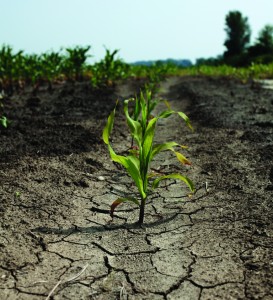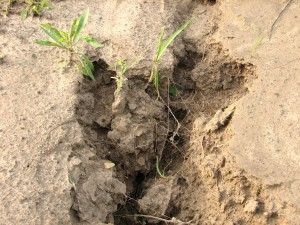Imagine a world where you wake to up to find a spring garden freshly tilled. Your back is free of kinks. Your chiropractic bill no longer exists.

Why? Because the titanic tiller gathering dust in the garage hasn’t eaten dirt since last year.
How is this miracle possible?
Look no further than the forage radish, a burgeoning cover crop that could end the need for breaking ground with mechanical methods.

Go Deep!
The forage radish–also known as oilseed radish, groundhog radish, and the trademarked tillage radish–has gained in demand with farmers looking for the no-till method. The thick upper part of the radish can root in the dirt over 20 inches. The taproot can go further, reaching several feet!
The method, called “bio-drilling”, breaks up soil compaction and improves soil fertility. Once the radish dies in the winter and its huge roots decompose, deep channels are left behind for new cash crop plantings. The deep impressions left by the radishes allows the new crop to find water more easily in the subsoil as well as being able to handle drought more readily.

Wait, There’s More!
The forage radish not only prevents tilling, but carries many of the traits of the superstar cover crops.
Here’s some advantages:
Weed Enemy: The radish’s rapidly emerging dense canopy suppresses late fall weed growth. Plus the plant’s allelopathic nature in the soil stifles weed growth even after a winter-kill.
Nutrient Provider Post-Mortem: The radish captures and stores while alive, and then release nutrients back into the soil during decomposition. It also releases a good amount of nitrogen in the early spring, giving young plants the added boost needed to survive the trial months.
Rooting for the Little Guys: Research shows that microbial life grows exponentially after growing the radish for several years.
Erosion Eradication: Radishes reduce runoff from rain residue in the spring. A majority of the water will go into the holes left by the decomposed taproots.

Before You Plant…
Make sure to allow the radish plenty of time before the first killing frost (in WNC, that typically happens by mid-November). Plant 3 to 10 weeks beforehand to give the radish plenty of time for optimal growth.
Leafy growth should commence within a week.
Fifth Season proudly carries the trademarked Tillage Radish.

David Cooke says
I am looking to purchase some forage radish seed. Do you all sell this product by mail?
Brandon Colman says
We do, indeed! Contact our Carrboro store (919) 932-7600 and we’ll be happy to put together and ship an order for you. You’re also welcome to email me at Brandon@fifthseasongardening.com.
Bryan says
Do you still have forage radish? Is it organic seed? I’ve been having difficulty finding some and I’d need it shipped.
Bill says
How do you order some of this?
Joyce says
These radishes are an abomination. I have lived on a farm all my life and I have never smelled such a ghastly mess. There are farmers who planted these things in this area due to so much prevented planting. No one had sufficient warning that the smell of decomposition would mimic a huge gas leak. These thing are going to set back agriculture years on air quality legislation. DO NOT PLANT these within a mile of a habitation. We had a 1000 head hog floor that cannot compare to the offensive smell of these plants breaking down.
Vladimir Pentovsky says
We have different kinds of radishes and turnips but we also a particular kind of radish similar to your “FORAGE RADISH OR TILLAGE RADISH”. In most cases we mix 50% perennial kura clover with 25% annuals and biennials and turnips and with 25% radish similar to your forage radish or tillage radish. The main aim is to create a permanent perennial living mulch cover crop through which the main crops will be planted. The annuals, biennials, turnips, and radish will grow and deep till the soil and we plant the seeds mixture at several times the recommended amount after inoculating it with peat containing nitrogen-fixing rhizobial bacterial inoculants and mychorrizal fungi inoculants. The aim is to allow the annuals, biennials, turnips, and radish to deep till the soil and bring up the subsoil nutrients up while co-existing and growing together with the perennial kura clover. Once the annuals, biennials, turnips, and radish has bolted and self-seeded themselves we then just mow-mulched the entire plot of land that has widely spaced rows of Siberian pea shrub acting as an alley-cropping shrub or tree. Then the kura clover takes over with it’s perennial roots’ root hairs maintaining the hollow spaces left by the roots of the annuals, biennials, turnips, and radish after consuming them after they have turned into humus and this creating a spongy type of soil structure maintained by the thick perennial kura clover.
This allows air and water to penetrate deeply and acting as a kind of biological storage chambers underground. The soil is first pre-tilled and mixed with rock dust powders mixtures and powdered activated food grade carbon made from coal or using activated powdered charcoal. The rock dusts powders mixtures will make the plants so strong that they can withstand anything that any climate changes can throw at them and increasing their yields by 4 to 5 times and accelerate their growth rates and maturation periods, and the activated food grade carbon powder or activated food grade powdered charcoal made from willows will increase yields by 880%. We did it for many decades even before rock dust powders and activated food grade carbon or charcoal used in making terra-preta soils was made public.
Regina says
My neighbor planted field radishes. Are they safe for human consumption? I took a small bite and they are delicious
ashley says
Yes, they are safe to eat. In fact another name for forage (tor tillage) radish is Daikon radish, used in many Asian cuisines. Enjoy!
Ron mac says
How many times can you grow these on the same ground,3 yrs,4 yrs,
Thanks
ashley says
Like other brassicas, radishes should generally not be planted more than two years in a row in the same ground to guard against possible build up of fungus in the soil.
Multilock Jagger says
ya it does
GASTON HUGO FERNANDEZ PALMA says
Hello. I´m farmer in no till since 1988. First apologize my “english”. Second since 1995 I work with cover crops ( oats, Vicia, Trtiticale), but i´ll try to use a multiseeds cover crops. and the problem is Weed resistence, here in the south east of Argentine we have a lot of resistence with crucifers ad I don´t know how work oilseed raphanus. Have you any information¿. Regards Gastón
Bill says
Hi. Can it be cut and made into silage? We have ample growth due to a good season and almost too much! Thank you
ashley says
Forage radishes are edible, so can be used as feed, but we’re not sure how they would store. I tried to do a little research on this topic, bit couldn’t really find anything very helpful. I’d contact your local agricultural extension agent and see if they might have more info about turning your radish “harvest’ into silage.
Robert Lawson says
They make great pickles.
hughmerdes says
reply: THANKS FOR YOUR GOOD WORDS. i am learning more about work oilseed raphanus.
Ton says
Ever the sceptical one, I have to ask how this plant can penetrate soil which is so awful and what crops need a soil which has been penetrated by several feet? I’ve never seen a vegetable with roots more than a foot long so it sounds like overkill. And finally, planting anything in August clay sounds like a big pain in the butt.